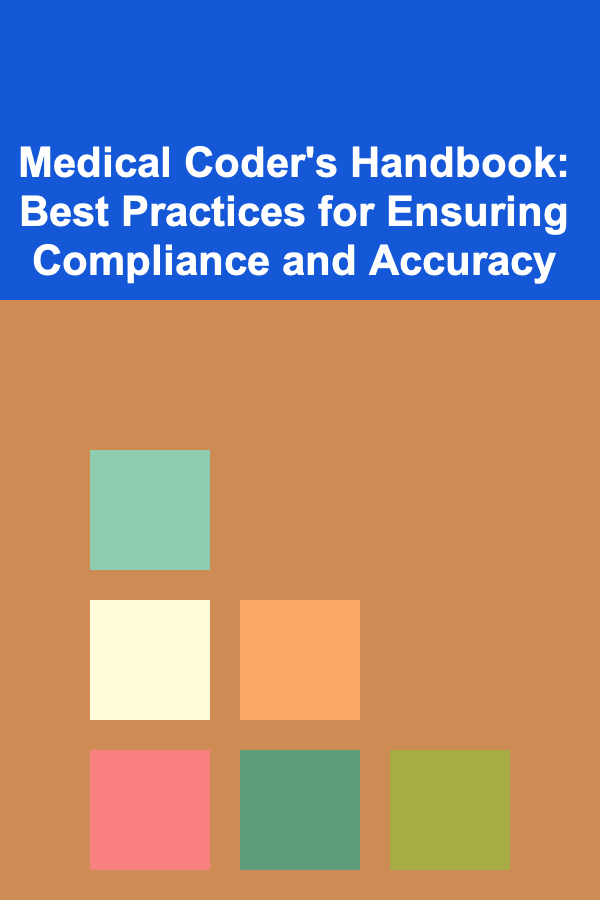
Medical Coder's Handbook: Best Practices for Ensuring Compliance and Accuracy
ebook include PDF & Audio bundle (Micro Guide)
$12.99$8.99
Limited Time Offer! Order within the next:

Medical coding is a pivotal aspect of the healthcare system. As a medical coder, you are responsible for converting healthcare diagnoses, procedures, and services into standardized codes that are used for billing, insurance claims, and maintaining patient records. Ensuring compliance and accuracy in medical coding is not just about following rules; it's about making sure that healthcare providers are reimbursed correctly and that patients receive the care they need without issues related to insurance.
This handbook is designed to provide you with actionable best practices for ensuring compliance and accuracy in your medical coding tasks. It is essential to understand that even minor errors in coding can lead to claim denials, delays in payments, and potential legal issues. With healthcare regulations constantly evolving, it's crucial to stay informed and adhere to the best practices. Below are the core principles and best practices every medical coder should adopt to ensure compliance and accuracy in their work.
Understand the Core Coding Systems Thoroughly
Medical coding involves using specific systems to assign codes to diagnoses, procedures, and treatments. The primary coding systems in the U.S. healthcare system are:
- ICD-10-CM (International Classification of Diseases, 10th Edition, Clinical Modification): Used to code diseases, conditions, and other healthcare-related events.
- CPT (Current Procedural Terminology): A system for coding medical, surgical, and diagnostic procedures and services provided by healthcare professionals.
- HCPCS Level II (Healthcare Common Procedure Coding System): This system codes services and products not included in CPT, such as durable medical equipment, ambulance services, and some drugs.
Best Practices:
- Regularly Review Updates: Each year, these coding systems undergo updates and revisions. As a medical coder, you must stay up-to-date with these changes. Refer to the official updates and manuals provided by institutions such as the American Medical Association (AMA) and the Centers for Medicare & Medicaid Services (CMS).
- Use Official Resources: The official coding books for ICD-10, CPT, and HCPCS should always be your primary resource. Avoid relying on third-party websites or resources that may not be accurate or up-to-date.
- Specialize in Relevant Codes: As you advance in your career, it can be beneficial to specialize in a particular type of coding (e.g., cardiology, orthopedics, or pediatrics). This allows you to become more familiar with the unique codes and procedures in that specialty.
Ensure Accurate and Complete Documentation
Accurate coding starts with accurate documentation. If a physician's documentation is incomplete, unclear, or inconsistent, you may struggle to assign the correct code, which can lead to errors.
Best Practices:
- Consult Comprehensive Medical Records: Always ensure that the patient's medical record is complete before coding. If there are any ambiguities or gaps in the documentation, communicate with the healthcare provider to clarify the details.
- Check for Consistency: Ensure the diagnoses in the medical record match the procedures provided. Any discrepancy between the diagnosis and treatment can lead to coding errors or claim denials.
- Be Detail-Oriented: In some cases, minor details can affect coding accuracy. For instance, identifying whether a procedure was performed on the left or right side of the body, or whether a patient has a primary versus secondary condition, can make a significant difference in the code selected.
Adopt a Methodical Approach to Coding
Medical coding requires precision, and adopting a systematic and organized approach can make all the difference in avoiding mistakes. This ensures that your work is consistent, thorough, and efficient.
Best Practices:
- Use the Coding Hierarchy: Start with a general diagnosis and narrow it down. For example, if you are coding for a heart condition, first choose the general ICD-10 code for cardiovascular diseases, then narrow it down to the specific condition using more detailed codes.
- Break Down Complex Codes: When dealing with more complex coding scenarios (such as multi-step surgeries or combined diagnoses), break down the coding process into manageable steps. Always start by identifying the most important codes and then add the modifiers or secondary codes as needed.
- Double-Check Codes: After assigning codes, always go back and verify that each code is correct by cross-referencing it with the medical record and guidelines. It's easy to miss a step or choose an incorrect code if you rush through the process.
Follow Payer-Specific Guidelines and Requirements
Different payers (insurance companies) may have slightly different guidelines, policies, and requirements for submitting claims. These can sometimes differ from the general coding rules or official coding guidelines. Therefore, familiarity with the payer-specific requirements is crucial for compliance.
Best Practices:
- Review Payer Policies: Familiarize yourself with each payer's specific coding guidelines, which may include restrictions on certain codes or special rules for modifiers. Keep updated on changes to payer policies to avoid mistakes.
- Understand Reimbursement Requirements: Be aware of the reimbursement procedures for various services. Some services may require additional documentation or codes to be reimbursed fully.
- Monitor Denials and Appeals: In the event of claim denials, always investigate the reason behind them. A high rate of denials may indicate coding errors that need to be corrected or clarified. Learn the appeal process and work with the provider's billing department to address issues.
Utilize Coding Software and Automation Tools
Modern medical coding is increasingly being supported by technology. Automation tools, coding software, and Electronic Health Record (EHR) systems can help speed up the coding process and reduce human error.
Best Practices:
- Integrate EHR with Coding Systems: Many EHR systems now include automated coding tools that suggest codes based on the information in the patient's chart. While these systems can save time, always verify their suggestions to ensure accuracy.
- Leverage Code Search Tools: Use reputable medical coding search engines or software to quickly find codes, especially when dealing with rare conditions or treatments. These tools can help you navigate complex codes more efficiently.
- Audit Software: Consider using auditing tools that help identify potential coding errors. These systems can catch mistakes early, allowing you to make corrections before claims are submitted.
Adhere to Ethical Coding Standards
Ethical behavior is essential for maintaining compliance and accuracy in medical coding. Avoiding fraudulent practices, such as upcoding (coding for more expensive procedures than what was performed) or downcoding (coding for less expensive procedures to reduce costs), is paramount.
Best Practices:
- Never Upcode or Downcode: Always choose the code that most accurately represents the service provided. Upcoding and downcoding can lead to significant legal issues and financial penalties for both the coder and the healthcare provider.
- Avoid Unnecessary Modifiers: Modifiers should only be used when necessary to provide additional information or explain the circumstances of a service. Misuse of modifiers can lead to claims being flagged as fraudulent or inaccurate.
- Follow Compliance Guidelines: Familiarize yourself with and adhere to guidelines set by the American Academy of Professional Coders (AAPC), the American Health Information Management Association (AHIMA), and the Centers for Medicare and Medicaid Services (CMS).
Implement Regular Audits and Peer Reviews
Even the most diligent coders can make mistakes. To ensure continuous compliance and accuracy, regular audits and peer reviews should be part of your routine.
Best Practices:
- Conduct Internal Audits: Set aside time regularly to review your work. This will help you identify recurring issues, common mistakes, and areas for improvement.
- Seek Peer Review: Whenever possible, have another coder review your work. A fresh pair of eyes can often catch errors you may have overlooked, ensuring that the final codes are as accurate as possible.
- Participate in External Audits: Third-party audits, often conducted by insurance companies or independent auditing firms, can provide insight into the accuracy of your coding practices and whether you are meeting industry standards.
Pursue Continuous Education and Certification
The field of medical coding is dynamic and constantly changing. Regulations, procedures, and coding guidelines are updated frequently. Staying ahead of these changes requires a commitment to continuous learning.
Best Practices:
- Obtain Certification: Certification from a recognized body such as AAPC or AHIMA can significantly boost your credibility and career prospects. Certification also demonstrates a high level of proficiency in coding and compliance standards.
- Participate in Ongoing Training: Attend workshops, webinars, and online courses to stay informed about the latest coding trends, regulations, and updates.
- Join Professional Networks: Being part of a professional organization like the AAPC provides access to resources, job opportunities, and industry insights, all of which can contribute to your growth as a medical coder.
Conclusion
Medical coding is an essential component of the healthcare industry, ensuring accurate billing, insurance claims, and proper patient records. By adhering to best practices such as maintaining up-to-date knowledge of coding systems, ensuring complete and accurate documentation, using technology, adhering to ethical standards, and continuously improving through education and audits, medical coders can ensure both compliance and accuracy in their work.
Remember, every accurate code you assign has an impact on the healthcare system, from proper reimbursement to maintaining patient care integrity. The best practices outlined here are not just about compliance---they're about maintaining the trust and integrity of the healthcare process as a whole.

How to Design Conference Materials: A Checklist for Professional and Informative Content
Read More
How to Handle Customer Service and Returns for Your T-Shirt Business
Read More
How to Handle the Eviction Process in a Home Rental Property Responsibly
Read More
How to Soundproof Your Home's Exterior for Less Street Noise
Read More
How to Update Your Home's Entryway for a Welcoming Feel
Read More
The Art of SEO: Enhancing Your Writing Skills to Drive More Traffic as a Content Writer
Read MoreOther Products

How to Design Conference Materials: A Checklist for Professional and Informative Content
Read More
How to Handle Customer Service and Returns for Your T-Shirt Business
Read More
How to Handle the Eviction Process in a Home Rental Property Responsibly
Read More
How to Soundproof Your Home's Exterior for Less Street Noise
Read More
How to Update Your Home's Entryway for a Welcoming Feel
Read More